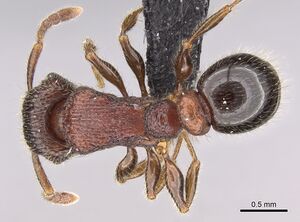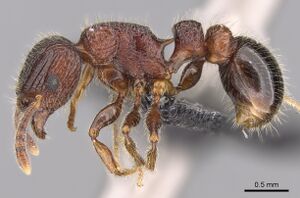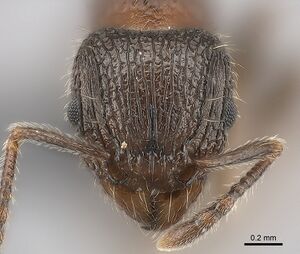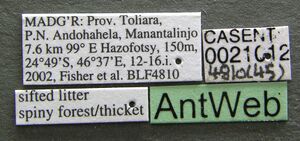Tetramorium hobbit
| Tetramorium hobbit | |
|---|---|

| |
| Scientific classification | |
| Kingdom: | Animalia |
| Phylum: | Arthropoda |
| Class: | Insecta |
| Order: | Hymenoptera |
| Family: | Formicidae |
| Subfamily: | Myrmicinae |
| Tribe: | Crematogastrini |
| Genus: | Tetramorium |
| Species group: | plesiarum |
| Species: | T. hobbit |
| Binomial name | |
| Tetramorium hobbit Hita Garcia & Fisher, 2014 | |
Tetramorium hobbit is likely a ground-active species since it was mainly collected from leaf litter extractions and pitfall traps.
Identification
A member of the Tetramorium plesiarum species group. Hita Garcia and Fisher (2014) - Tetramorium hobbit is easily recognisable within the T. plesiarum species group due to its massively developed petiolar node and very conspicuous reticulate-punctate ground sculpture on head and mesosoma.
Tetramorium hobbit is very unlikely misidentified with the other four species of the group. The massively enlarged petiolar node, in combination with the distinct reticulate-punctate ground sculpture on head and mesosoma, are not seen in any other group member. However, of all group members, Tetramorium mars seems morphologically closest to T. hobbit, especially on the basis of the blockier petiolar node shape seen in profile that both species share. However, in addition to the smaller petiolar node and the lack of reticulate-punctate ground sculpture on head and mesosoma, T. mars also has shorter antennal scapes (SI 58–62; DPeI 108–122) and a narrower petiolar node in dorsal view than T. hobbit (SI 64–67; DPeI 133–148). Tetramorium mars (HW 0.69–0.74; WL 0.83–0.96) is also smaller than T. hobbit (HW 0.80–0.88; WL 0.96–1.10)
One noticeable intraspecific variation can be observed within T. hobbit. There are two distinct groups with differently developed propodeal spines. The populations from the type localities Tsimanampetsotsa and Andohahela always have relatively long spines (PSLI of 28–29), which contrast with the much shorter spines seen in the material from in Beroboka, Kirindy, Isalo, and the Makay Mountains (PSLI 18 -20). This difference is very pronounced and constant in all of the examined material.
Keys including this Species
Distribution
The distribution of T. hobbit is approximately restricted to the southern third of the island of Madagascar. In the south, the distribution range encompasses the type locality Tsimanampetsotsa in the west and Andohahela in the east, while the Makay Mountains and Isalo mark the northernmost known localities. Interestingly, the population in Andohahela seems to be slightly isolated from the other, more western localities. However, we consider this to be more of a sampling artifact.
Latitudinal Distribution Pattern
Latitudinal Range: -20.7953° to -24.8169°.
| North Temperate |
North Subtropical |
Tropical | South Subtropical |
South Temperate |
- Source: AntMaps
Distribution based on Regional Taxon Lists
Malagasy Region: Madagascar (type locality).
Distribution based on AntMaps
Distribution based on AntWeb specimens
Check data from AntWeb
Countries Occupied
| Number of countries occupied by this species based on AntWiki Regional Taxon Lists. In general, fewer countries occupied indicates a narrower range, while more countries indicates a more widespread species. |

|
Estimated Abundance
| Relative abundance based on number of AntMaps records per species (this species within the purple bar). Fewer records (to the left) indicates a less abundant/encountered species while more records (to the right) indicates more abundant/encountered species. |

|
Habitat
Like the remainder of the species group, T. hobbit prefers arid habitats, such as tropical dry forests, spiny forests and thickets, savannah woodland, and barren rocks with little vegetation. It is found at elevations of 80 to 923 m.
Biology
Castes
Images from AntWeb
    
| |
| Holotype of Tetramorium hobbit. Worker. Specimen code casent0019207. Photographer Cerise Chen, uploaded by California Academy of Sciences. | Owned by CAS, San Francisco, CA, USA. |
   
| |
| Worker. Specimen code casent0020993. Photographer Shannon Hartman, uploaded by California Academy of Sciences. | Owned by CAS, San Francisco, CA, USA. |
   
| |
| Queen (alate/dealate). Specimen code casent0021012. Photographer Shannon Hartman, uploaded by California Academy of Sciences. | Owned by CAS, San Francisco, CA, USA. |
   
| |
| Worker. Specimen code casent0079245. Photographer Shannon Hartman, uploaded by California Academy of Sciences. | Owned by CAS, San Francisco, CA, USA. |
Nomenclature
The following information is derived from Barry Bolton's Online Catalogue of the Ants of the World.
- hobbit. Tetramorium hobbit Hita Garcia & Fisher, 2014: 42, figs. 10A, 12A, 17, 62 (w.) MADAGASCAR.
Unless otherwise noted the text for the remainder of this section is reported from the publication that includes the original description.
Description
Worker
(N=12). HL 0.79–0.88 (0.84); HW 0.80–0.88 (0.85); SL 0.52–0.58 (0.55); EL 0.16–0.20 (0.18); PH 0.42–0.53 (0.47); PW 0.63–0.72 (0.69); WL 0.96–1.11 (1.04); PSL 0.16–0.25 (0.20); PTL 0.28–0.31 (0.30); PTH 0.40–0.46 (0.44); PTW 0.38–0.45 (0.41); PPL 0.24–0.30 (0.27); PPH 0.39–0.45 (0.43); PPW 0.45–0.54 (0.51); CI 100–102 (101); SI 64–67 (65); OI 19–22 (21); DMI 63–72 (66); LMI 43–50 (46); PSLI 18–29 (23); PeNI 57–66 (60); LPeI 63–71 (68); DPeI 133–148 (140); PpNI 69–76 (74); LPpI 60–67 (63); DPpI 175–200 (188); PPI 116–126 (122).
Head as long as wide to weakly longer than wide (CI 100–102); posterior head margin weakly concave. Anterior clypeal margin with distinct median impression. Frontal carinae strongly developed and forming dorsal margin of very well-developed antennal scrobes, scrobes moderately to very deep and with clearly defined margins all around; median scrobal carina very well developed and distinctly surpassing posterior eye level, usually approaching posterior scrobe margin. Antennal scapes short, not reaching posterior head margin (SI 64–67). Eyes relatively small to moderate (OI 19–22). Mesosomal outline in profile conspicuously convex, rounded and often very high (LMI 43–50), moderately marginate from lateral to dorsal mesosoma; promesonotal suture and metanotal groove absent. Propodeal spines either short and elongate-triangular or long and spinose (PSLI 18–29; material from Andohahela and Tsimanampetsotsa with PSLI of 28–29; material from other localities PSLI 18–20), spines always with broad base and acute tip; propodeal lobes well developed, elongate triangular, and acute, always shorter than propodeal spines. Petiolar node massively developed, very large, in profile high, rectangular, blocky nodiform with well defined antero- and posterodorsal margins, between 1.4 to 1.6 times higher than long (LPeI 63–71), anterior and posterior faces approximately parallel, anterodorsal and posterodorsal margins situated at about the same height, petiolar dorsum flat to weakly convex; node in dorsal view around 1.3 to 1.5 times wider than long (DPeI 133–148), in dorsal view pronotum around 1.5 to 1.7 times wider than petiolar node (PeNI 57–66). Postpetiole in profile subglobular to anteroposteriorly compressed, approximately 1.5 to 1.7 times higher than long (LPpI 60–67); in dorsal view around 1.7 to 1.9 times wider than long (DPpI 175–200), pronotum around 1.3 to 1.4 times wider than postpetiole (PpNI 69–76). Petiole in profile much more voluminous than postpetiole, in dorsal view postpetiole only about 1.1 to 1.3 times wider than petiolar node (PPI 116–126). Mandibles usually finely longitudinally rugulose, fairly smooth and shiny, sometimes unsculptured; clypeus longitudinally rugose, usually with five to seven very distinct and strong rugae, median ruga better developed than remainder, rugae usually without cross-meshes; cephalic dorsum between frontal carinae with 11 to 13 longitudinal rugae, rugae running from posterior clypeal margin to posterior head margin, often interrupted or with cross-meshes, especially posteriorly; scrobal area mostly unsculptured, only with ground sculpture; lateral head mainly reticulate-rugose. Mesosoma laterally reticulate-rugose to irregularly longitudinally rugose, dorsally mostly longitudinally rugose. Forecoxae unsculptured, smooth, and shining, often with weak traces of ground sculpture. In profile, basal half of petiolar node mostly unsculptured, upper half distinctly reticulate-rugose, dorsum of node distinctly reticulate-rugose; sculpture on postpetiole much weaker, laterally and dorsally only weakly rugulose. Gaster usually unsculptured, smooth and shining, sometimes with weak punctate ground sculpture at base of tergite. Ground sculpture on head, mesosoma, and petiolar node very conspicuous, usually strongly reticulate-punctate; ground sculpture on postpetiole and gaster usually much weaker but present, though sometimes absent. Whole body with very abundant, long, and fine standing hairs; first gastral tergite with abundant, long, erect hairs and much scarcer, shorter, decumbent to subdecumbent hairs. Anterior edges of antennal scapes and dorsal (outer) surfaces of hind tibiae with decumbent to suberect hairs. Body reddish to dark brown, head and gaster usually darker than rest of body.
Type Material
Holotype, pinned worker, MADAGASCAR, Toliara, Parc National de Tsimanampetsotsa, Forêt de Bemanateza, 20.7 km 81° E Efoetse, 23.0 km 131° SE Beheloka, 23.99222°S, 43.88067°E, 90 m, spiny forest/thicket, sifted litter (leaf mold, rotten wood), collection code BLF06254, 22.–26.III.2002 (B.L. Fisher et al.) (California Academy of Sciences: CASENT0019207). Paratypes, 2 pinned workers with same data as holotype (CAS: CASENT0019210; CASENT0019227); 2 pinned workers with same data as holotype except collected from pitfall trap and collection code BLF06258 (CAS: CASENT0078055; Musee d'Histoire Naturelle Genève: CASENT0078059); 5 pinned workers with same data as holotype except collected from ground nest and collection code BLF06270 (CAS: CASENT0445004; CASENT0445005); and 2 pinned workers with same data as holotype except sampled from ground and collection code BLF06337 (Museum of Comparative Zoology: CASENT0445502; CASENT0445520).
Etymology
This very hairy new species is named after the fictional people from J.R.R. Tolkien’s novels “The Hobbit” and “The Lord of the Rings”. The species epithet is an arbitrary combination of letters, thus invariant.
References
References based on Global Ant Biodiversity Informatics
- Hita Garcia F, and B. L. Fisher. 2014. The hyper-diverse ant genus Tetramorium Mayr (Hymenoptera, Formicidae) in the Malagasy region - taxonomic revision of the T. naganum, T. plesiarum, T. schaufussii, and T. severini species groups. ZooKeys 413: 1-170.

